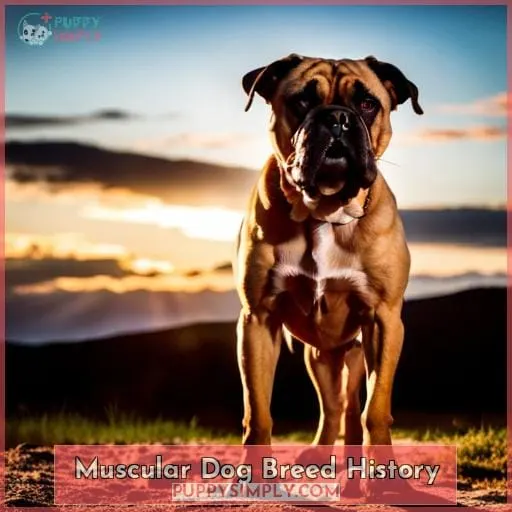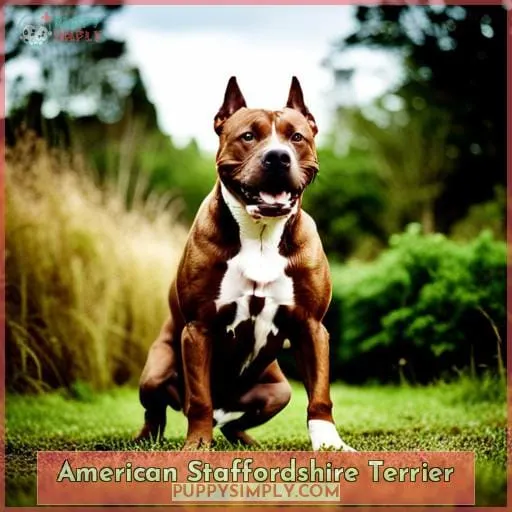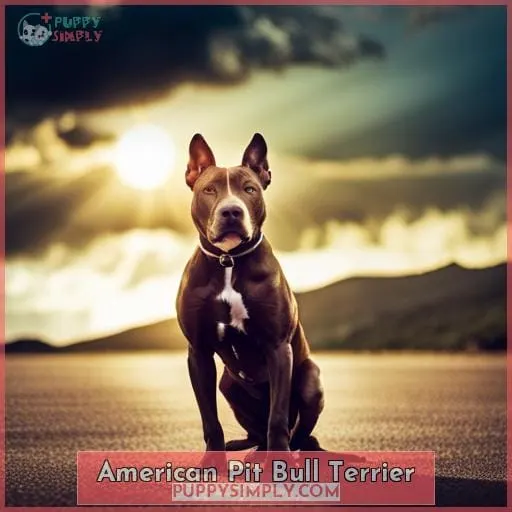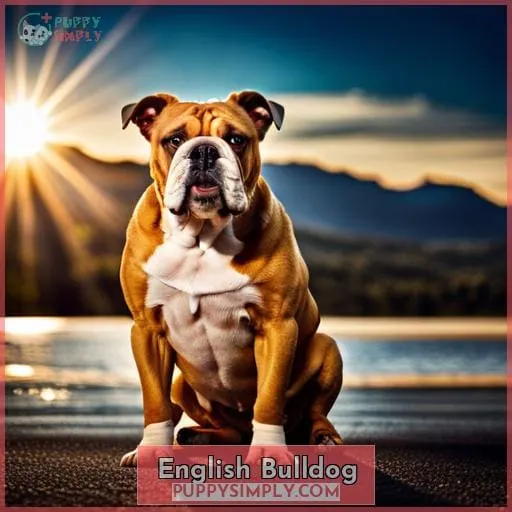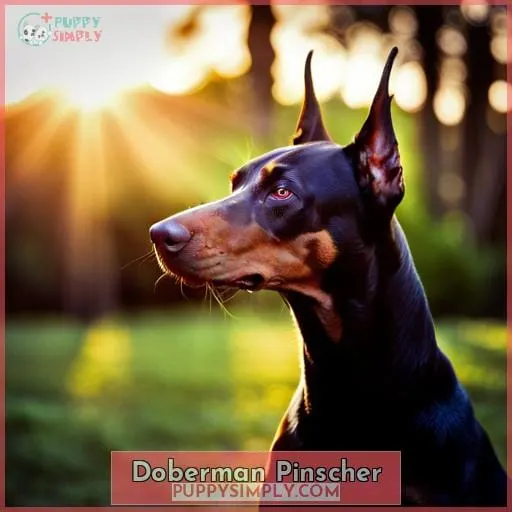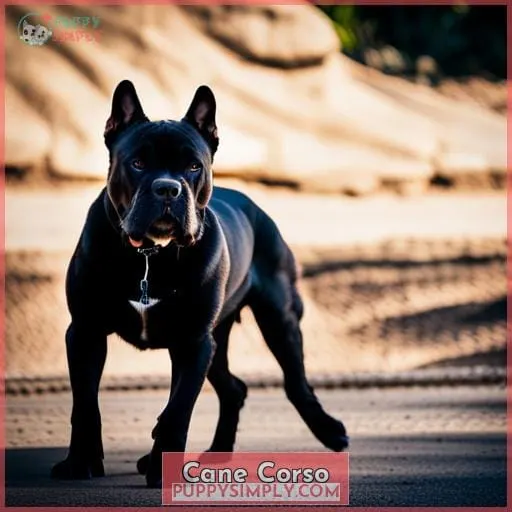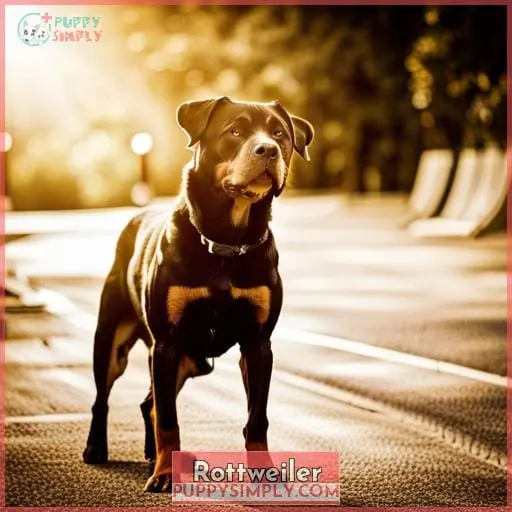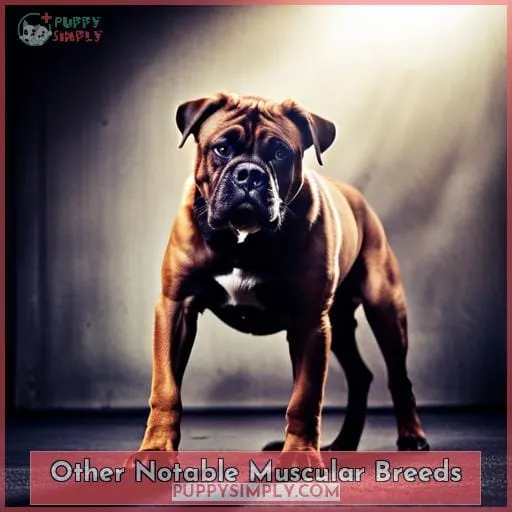This site is supported by our readers. We may earn a commission, at no cost to you, if you purchase through links.
 Are you looking for a muscular dog to protect your family and property?
Are you looking for a muscular dog to protect your family and property?
One that will be a loyal companion and a powerful deterrent to intruders?
If so, you’ve come to the right place.
In this article, we’ll introduce you to the most muscular dog breeds that are known for their strength, loyalty, and protective instincts.
From the American Staffordshire Terrier to the Rottweiler, these breeds have been carefully selected for their ability to provide you with the peace of mind that comes with knowing your home and loved ones are safe.
Table Of Contents
- Key Takeaways
- Muscular Dog Breed History
- Is It Safe to Own Muscular Dogs?
- American Staffordshire Terrier
- American Pit Bull Terrier
- English Bulldog
- Doberman Pinscher
- Cane Corso
- Rottweiler
- Greyhound
- Other Notable Muscular Breeds
- Frequently Asked Questions (FAQs)
- What are the best muscular dog breeds for families with young children?
- How much exercise do muscular dog breeds need each day?
- What health issues are common in muscular dog breeds?
- How can I find a responsible breeder of muscular dogs in my area?
- Are there any rescues that specialize in muscular dog breeds?
- Conclusion
Key Takeaways
- Proper socialization and training from a young age are crucial.
- Regular vigorous exercise and physical activity are essential for health.
- Be aware of any local regulations restricting certain muscular breeds.
- Gentle, family-friendly muscular breeds include American Staffordshire Terriers and Boxers.
Muscular Dog Breed History
You’re probably familiar with muscular dog breeds being used as guard dogs and for protection.
Historically, many bully breeds and mastiff breeds were developed specifically for these purposes due to their strength, bravery, and loyalty.
Let’s take a quick look at the background of a few key muscular breeds often utilized for protection or as loyal companions.
Bully Breeds
You’ve likely seen some bully breeds, which are muscular dog breeds originally developed for bull baiting and dog fighting.
-
American Pit Bull Terriers:
- Bred for strength and bull-baiting
- Energetic and easy to train
-
American Staffordshire Terriers:
- Developed for dog fighting
- Athletic build
- Devoted companions
-
Dogo Argentino:
- Powerful hunting dogs
- Need daily quality time with owners
These breeds require experienced training and socialization to prevent mishaps. Their energetic nature demands lots of exercise.
Mastiff Breeds
Your Mastiffs’ formidable size and strength come from their history as guardians and protectors.
Their muscular frames served as living, guardian tools.
Breeds like Boxers, Rottweilers, Cane Corsos, and Doberman Pinschers all descend from ancient Mastiff breeds.
Care and socialization are key for these powerful pups to blossom into gentle guardians rather than aggressive attackers.
Is It Safe to Own Muscular Dogs?
Now that you have learned about the fascinating history of muscular dog breeds, it’s time to address an important question: Is it safe to own these powerful dogs?
The answer is yes, but with certain precautions and responsible ownership.
Here are some tips for safe ownership:
- Exercise Needs: Muscular dogs require regular exercise and physical activity to stay healthy and avoid boredom-induced behavior issues.
- Socialization Importance: Proper socialization from a young age is crucial for muscular breeds, as they can be more prone to aggression if not properly introduced to different people, animals, and environments.
- Positive Reinforcement Training: Utilize positive reinforcement methods when training your muscular dog breed instead of harsh or punitive techniques.
- Local Regulations Awareness: Be aware of any local regulations or restrictions regarding owning specific muscle-bound breeds.
By following these safety guidelines along with matching your lifestyle and providing ample love and care through bonding activities like daily walks or play sessions will help ensure a harmonious relationship between you and your beloved companion – a loyal protector who’ll bring joy into your life while keeping you safe!
American Staffordshire Terrier
One has likely seen an American Staffordshire Terrier, with their stocky and muscular build, without realizing their history as tenacious workers bred for bull-baiting.
Despite their unfortunate past, this energetic and devoted companion evolved into a family dog.
Proper training techniques like positive reinforcement shape them into gentle protectors.
Consider health issues like hip dysplasia.
Follow breed-specific regulations since some places restrict bully breeds.
Their loving loyalty makes them ideal for an active home seeking safety in muscular companions.
Incorporate no prong or choke collars.
Rather, use rewards-based training for these intelligent dogs eager to please energetic owners searching for protection and camaraderie.
American Pit Bull Terrier
You’d be amazed how the American Pit Bull Terrier grew into farm dogs after developing from breeds created for strength and bull-baiting.
- Wide chest and distinct muscular build perfect for strength training.
- Males can grow up to 21 inches tall and weigh up to 60 pounds.
They became perfect sweethearts that are unbelievably sociable.
From bull-baiting origins to farm dogs and modern-day companions, they evolved along with history.
Their energetic and friendly temperament makes them ideal protective companions.
English Bulldog
You’ll find that despite their well-muscled physique with scars of a terrible past, the English Bulldog lacks drive today, often snorting and wheezing while being quite lethargic.
Originally bred in England for the brutal sport of bull-baiting, they’ve a storied history of strength and tenacity.
However, selective breeding has made them one of the calmest, friendliest breeds that thrives as a family pet.
Their easygoing temperament and patience with children makes them reliable companions.
Proper care includes regular vet visits, skin fold cleaning, nail trimming, and weight management.
Though mellow couch potatoes now, their strong appearance still deters intruders, providing a sense of safety and belonging.
Daily walks and play sessions ensure proper muscle tone and joint health for this heavy, short breed.
Doberman Pinscher
You’ve likely seen the Doberman pinscher’s muscular physique concentrated in their powerful front halves.
This breed is known for their:
- Protective instincts and loyalty towards their family and pack. Dobermans will defend their loved ones if they sense danger.
- High intelligence and trainability. With proper socialization and firm leadership, Dobermans can be wonderful companions.
- Athleticism and stamina. These energetic pups need plenty of exercise and mental stimulation.
Despite their imposing looks, most Dobermans are sweet and gentle dogs when raised responsibly.
With devoted owners providing proper care and training, this breed makes for a vigilant and affectionate member of the family.
Cane Corso
Let’s move on to discussing the Cane Corso.
As the name implies, this Italian mastiff was originally bred to work—specifically guarding property and hunting big game.
Don’t let their intimidating appearance fool you though. While protective instincts run deep in the breed, Cane Corsos raised properly make for outstanding companions.
Proper training and socialization is paramount for the Cane Corso due to their heritage and tendency towards dominance.
Provide structure through daily obedience training, and expose them to new sights, sounds, people, and animals frequently.
If you put in the work upfront, you’ll reap the rewards of a loyal guardian that lives to please its family.
| Training Difficulty | Exercise Needs | Family Friendliness |
|---|---|---|
| Moderate | High | Moderate |
With appropriate handling, Cane Corsos thrive as home protectors and furry playmates.
Their energetic and willful temperament simply requires an experienced owner willing to be the pack leader.
Rottweiler
Your eighth most muscular dog breed is the Rottweiler. Known for their calm, brave, and heavy build, Rottweilers are extremely loyal and protective companions.
Rottweilers are large, sturdy dogs with thick necks and very muscular bodies. Males can reach 27 inches tall and weigh up to 135 pounds.
They need extensive training and socialization from an early age to control their protective instincts and achieve obedient behavior. Rottweilers bond deeply with their owners and can become overprotective if not handled properly.
Common health issues to watch for include hip and elbow dysplasia, heart conditions, eye diseases, and some cancers.
Overall, Rottweilers are steadfast companions that thrive when given proper leadership and activity.
Greyhound
For the subtopic on Greyhounds in your article entitled Most Muscular Dog Breeds for Protection and Loyal Companions, you could begin the subtopic like this:
You’d never guess these lean racing dogs are pure muscle under their short coats. Greyhounds are the sprinting athletes and racing champions of the dog world, known for their elegance in motion.
Bred for coursing competitions and racing, they’re gentle dogs that make great pets when properly trained and socialized.
Their aerodynamic physique allows them to reach speeds over 40 miles per hour.
Retired racing greyhounds need significant daily exercise and stimulation.
With proper greyhound care, these docile yet athletic canines can thrive as wonderful companions and one of the best muscular dog breeds.
Other Notable Muscular Breeds
You’ll also find other muscular dog breeds like the Rhodesian Ridgeback, Bandog, and the large yet friendly American Alsatian.
These notable companions possess both strength and loyalty, making them ideal athletic guardians.
The Rhodesian Ridgeback’s muscular build comes from its history of hunting and guarding livestock in Africa.
Bandogs, a cross between various Mastiff and Bulldog breeds, have the powerful protective instincts of their parents.
While intimidating in size and strength, the American Alsatian’s friendliness earns it the nickname gentle giant.
Despite their muscular beauties, these breeds crave human companionship and make devoted powerful protectors for the right families.
With proper socialization and training, their strength and loyalty shine through any tough exterior.
Frequently Asked Questions (FAQs)
What are the best muscular dog breeds for families with young children?
Choose gentle-natured breeds like American Staffordshire Terriers or Boxers.
Their muscular appearance deters threats while their loving temperament bonds with kids.
Train and socialize them young to nurture their protective instincts.
Supervise all interactions.
How much exercise do muscular dog breeds need each day?
Muscular dog breeds require at least 60-90 minutes of vigorous exercise daily.
Their energetic nature and muscular builds demand significant physical activity and stimulation to stay fit and content.
Structured walks, play, training, hiking, and swimming are excellent ways to meet their needs.
What health issues are common in muscular dog breeds?
Certain health issues arise in some muscular breeds.
Joint problems like hip dysplasia plague larger dogs.
Brachycephalic breeds struggle with breathing issues.
Overheating and cardiac problems can occur too.
Proper nutrition and veterinary care help minimize these risks.
But responsible breeding is key.
How can I find a responsible breeder of muscular dogs in my area?
Research local kennel clubs and specialty breed groups.
Carefully vet breeders by:
- Verifying health certifications
- Observing the animals and facilities in-person
- Asking for references from previous buyers
Select someone focused more on the welfare of their dogs than profit.
Are there any rescues that specialize in muscular dog breeds?
Bully breed rescues exist nationwide, caring for gentle giants.
Ever considered providing furry friends a loving home?
With training and socialization, they become perfect companions.
Conclusion
So choose your canine companion wisely.
Look deep into those loyal, loving eyes and see the strength within.
With a muscular dog by your side, you’ll sleep soundly knowing they’ve got your back.
Their power lies not in aggression, but devotion – to protect all that you hold dear.
Embrace their gentle spirit, forged through time to be your guardian.
Therein lies the heart of a hero that beats for you.

